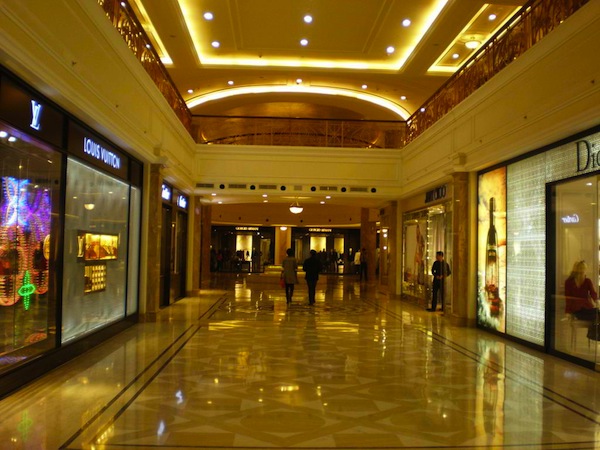The global luxury market is set to see its slowest growth this year since 2009, with the Asian market in particular contributing to the slump. French luxury brands Gucci and Louis Vuitton, for example, recently reported drops in Chinese sales as consumers showed a preference for “logo-free” clothing and accessories.
In a turn of events, it’s the US that is expected to be a strong luxury market over the next five years, according to a new study by Departures magazine in association with Ledbury Research. Top luxury CEOs ranked North America as the most important growth market, followed by East Asia, Western Europe, Eastern Europe, and Central/South America. Despite China’s blistering economic growth in recent years, it is actually the US that created 94 percent of the world’s new millionaires over the past year, according to Credit Suisse.
But some of the more intriguing recent data regarding the global luxury market may be coming out of India. A new report published by the Confederation of Indian Industry and IMRB International, a market research firm found that over the past three years, the Indian luxury market has grown around 15 percent, with the highest interest in luxury products as opposed to luxury services. Driving that growth is India’s “Closet Consumer.”
What exactly is a “Closet Consumer”? According to Sushmita Balasubramaniam, VP of IMRB’s Retail Business Unit, “Typically these are people who have not been born wealthy and luxury is not a way of life yet—they are just experimenting with luxury.” Some researchers classify these individuals as “new age high net worth individuals,” who are more discriminating about luxury items.
Sanjay Kapoor of Genesis Luxury adds, “The growth is coming from the new money in India—professionals earning Rs 300,000 to Rs 700,000 ($4,700 to $11,000) a month, new businesses, emerging businesses, young people starting at nibbling levels for consumption of luxury.” Watches are especially popular with luxury newbies, but women’s fashion is highly popular among India’s new wealthy consumers.
While India accounts for less than 2 percent of the global luxury market, it is interesting to watch new wealth emerge, particularly since many of these individuals still have a “middle class mindset.” According to Balasubramaniam, Closet Consumers “won’t pick up a Louis Vuitton [bag] because it’s Louis Vuitton. They examine it and have to see value.” Sanjana Chauhan, founder of luxury brand consultant LuxuryNext, says, “The new Indian luxury buyer is not just aware of brands, but also knows exactly what he wants. While he values and buys international luxury brand offerings, he also appreciates his Indian roots and culture.”
Perhaps that value-minded outlook will put Indian consumers on par with their Asian counterparts who are increasingly moving away from brand and logo-based luxury items, such as handbags printed with Louis Vuitton’s signature monogram or Burberry’s muted plaid. But that doesn’t mean that the sector’s most iconic brands aren’t in demand. More luxury-only malls are opening in India, as major destination DLF Emporio mall has over 20 luxury brands waiting to gain space in the shopping complex in New Delhi.
And the key to attracting business from young, newly-wealthy buyers is personalization and service. Careful to not portray arrogance, retailers and personnel go out of their way to track consumer preferences and tailor shopping experience in order to make first-time luxury customers feel comfortable—a important aspect for a people with “middle-class mindset.”
But India has far to go before it can begin to compare its offerings and service with markets like China, whose $25 billion luxury market dwarfs India’s $6 billion one. Perhaps the biggest challenge facing luxury brands in the country is not the lack of deep-pocketed consumers but India’s complicated retail policies and undeveloped infrastructure. But until improvements are made, brands like Dior can be satisfied with selling premium-priced belts, wallets and watches. Surely, the couture clothing won’t be far behind.
Via : brandchannel.com
Connect With Us
Related Posts
- Real Estate Act comes into effect: 10 things you need to know about new law ( May 4, 2017 )
- Expats Living in Comfort – Hyderabad, India ( May 4, 2017 )
- MNC queue to Hyderabad grows longer; JP Morgan & IBM look for office space ( June 22, 2016 )
- An Apple in Hyderabad’s IT Garden: CEO Tim Cook’s big announcement Today ( May 19, 2016 )
- Hyderabad May get Disneyland Park ( April 22, 2016 )
- Indian Office Space Absorption Up 11% in Q4: Survey ( April 13, 2016 )
- Cognizant plans to add 8,000 people at Hyderabad facility ( March 9, 2016 )
- Ranked 139 in world, Hyderabad is Best Indian City to Live in ( February 24, 2016 )
- The Platina – Exclusive Commercial Space, Hyderabad ( February 19, 2016 )
- Apple, Inc set to open new $25 million Tech Center in Hyderabad, India by June ( February 16, 2016 )
Recent Posts
Recent Comments
Archives
- February 2018
- October 2017
- May 2017
- June 2016
- May 2016
- April 2016
- March 2016
- February 2016
- January 2016
- December 2015
- November 2015
- October 2015
- July 2015
- June 2015
- May 2015
- April 2015
- March 2015
- February 2015
- December 2014
- November 2014
- October 2014
- September 2014
- August 2014
- July 2014
- June 2014
- May 2014
- April 2014
- March 2014
- February 2014
- January 2014
- December 2013
- November 2013
- October 2013
- September 2013
- August 2013
- July 2013
- June 2013
- May 2013
- April 2013
- March 2013
- February 2013
- January 2013
- December 2012
- November 2012
- October 2012
- September 2012
- August 2012
- July 2012
- June 2012
- May 2012
- April 2012
- March 2012
- February 2012
- January 2012
- December 2011
- November 2011
- October 2011
- September 2011
- July 2011
- June 2011
- May 2011
- March 2011
- November 2010
- October 2010
- September 2010
- August 2010
- July 2010
- May 2010
- April 2010
- March 2010
- February 2010





Leave a reply